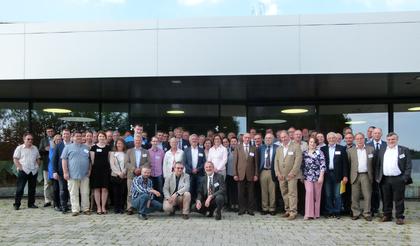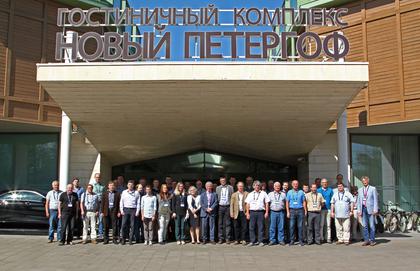Work Package 3
Science cooperation with the NICA collider facility in the field of ion beams and heavy ion physics
Work Package Lead: Jürgen Eschke
J.Eschke@gsi.de
GSI Helmholtzzentrum für Schwerionenforschung, Darmstadt (Germany)
FAIR Facility for Antiproton and Ion Research, Darmstadt (Germany)
Russian partner: Joint Institute for Nuclear Research
Objectives:
Enhanced cooperation and exchange of know-how on designing and constructing detector and accelerator components is a very important objective for the realization of the NICA and FAIR accelerator complexes. Both partners are already strongly involved in common activities to bundle their resources and create additional synergies. This work package will strengthen this cooperation by providing support in coordination, reviewing and training. Furthermore it will address the aspects of internationalization at JINR.
The first cooperation issue regards accelerators where joint developments of components for the low energy heavy ion collider NICA and the HESR storage ring at FAIR are to be pursued. The second topic of utmost importance is the cooperation between NICA and FAIR in the development and construction of detectors for experiments including front-end electronics and handling of huge date volumes. There is already support from scientists of the FAIR experimental collaboration “Compressed Baryonic Matter” (CBM) for the development of the Internal Tracker of the “Multi-Purpose-Detector” (MPD) experiment at NICA and as first step for the fixed-target experiment BM@N at JINR. Vice versa Russian scientists participate in the CBM collaboration.
The main objective is to intensify this important cooperation and to develop joint prototypes of silicon strip detectors and the challenging front end electronics for the experiments BM@N, MPD and CBM. The joint development of the silicon tracking systems at GSI/FAIR and JINR offers very large synergy effects with the final goal to build the challenging tracking detectors for the CBM Silicon Tracking System (STS), the BM@N inner tracking detector and the MPD Internal Tracker (IT) from the same components.
Finally, efforts are necessary to attract more scientists from EU countries to join the NICA experimental collaborations. This important issue is addressed in the last task of this proposal and amongst others evaluating the collaboration under task 3.1 and work out lesson learned.
This work package addresses the coordination on the joint development of silicon detectors to be used at FAIR and NICA as well as cooperation on accelerator components (see task 3.1 and subtasks) and on internationalisation of the NICA experiment collaborations (see task 3.2).
Task 3.1: Coordination of joint developments of main components of the Silicon Tracking System
Task 3.1.1 Technical management
The tracking system of a forthcoming frontier high-energy nuclear physics experiment requires high-speed readout capability (up to event rates as high as 10 MHz), and a very low material budget (~1% of radiation length per tracking layer). In order to minimize the material budget, the read-out electronics with all supply and cooling services will be placed outside of the active area of the detector resulting in several technological challenges:
- development of double-sided and single-sided radiation hard silicon micro-strip sensors;
- development of low-capacitance ultra-low mass multi-layer fine-pitch readout micro-cables that transmit signals from sensors to the readout electronics, forming a so called module;
- development of assembly sequences and custom designed tooling for assembly of ladders with up to 10 modules, mounted on ultra-low mass carbon fibre supports that can be installed into both planar and barrel tracking stations;
- integration of all components into a detector station which will be operated for several years in a harsh radiation environment.
A tracking detector system based on ultra-low mass ladders with double sided micro-strip silicon sensors could be used both in the CBM experiment at FAIR, where the ladders will be arranged in several planar tracking stations and in the "Multi Purpose Detector" (MPD) at NICA, which will require the arrangement of the ladders in concentric barrels. In order to achieve the goal of a common detector platform, several topics on sensors, micro cables and front-end chips need to explored:
Sensors
Both double-sided and single-sided prototype silicon micro-strip sensor prototypes have been produced by different vendors designed for a total dose of 1·1014 neq/cm2. An important feature of the sensors is that they can be chained to form sectors without dead areas due to the stereo angle. Two solutions are under investigation to provide additional connectivity to readout the corner areas: sensors with a second metal layer and ultra-light micro-cables bonded on single metal layer sensors. The performance tests of the sensors in the laboratory and with particle beams are ongoing both in Germany and are to be continued at JINR.
Micro cables
The micro-cables have been designed at GSI, and several samples of various sizes have been developed and fabricated by SE RTIIE and LTU in Kharkov. The fabrication of prototype cables is in progress. Tests of the cables will be performed.
Read out ASICs (STS-XYTER chip) and Front End Boards
For the application in the CBM silicon tracker, a new ASIC is being developed by the CBM Collaboration. A prototype version of the ASIC has been submitted for production. The STS-XYTER ASIC is optimized for the beam conditions at FAIR and well suited also for applications at the JINR Nuclotron. The focus is on establishing assembly procedures for a high-yield board assembly, in particular with respect to the handling of the high-density signal line cables arriving at the ASICs, as well as the effective heat removal from the boards.
Task 3.1.2: Organisation of technical review meetings for each component and final Production Readiness Review
The monitoring of the quality of the developed sensors, cables and chips is a very important activity within this task. Regular technical review meetings will be jointly organized including the final Production Readiness Review with external experts. This represents the most important milestone in this WP as the final evaluation will show if the components fulfil the requirements to start the mass production for the silicon detectors at NICA and FAIR.
Task 3.1.3: Initiation of expert training for the assembly of the components to modules and ladders
Laboratories for assembly and quality assurance have to be installed and equipped at FAIR/GSI and JINR. Clean rooms with semi-automatic bonding machines and probe stations are available at GSI and are equipped at JINR at present. Dedicated and sophisticated tooling for the assembly of modules, ladders (several modules), and stations (several ladders) have to be produced. Therefore, personnel have to be trained at all assembly sites. The initiation of the training is to be organized by JINR. The other assembly sites at FAIR/GSI shall benefit from the training and use the experts for the assembly during the production phase of this project.
Task 3.1.4: Organisation of workshops for the joint development of experiment and accelerator components for NICA and FAIR
As described before several workshops will be organized with the following scopes:
- On technical questions for the different components of the silicon tracking system
- Project meetings to organize the workflow for development, production and assembly of the silicon tracking system
- On front-end-electronics, data transport and online processing of huge data volumes
- On knowledge exchange for the joint development of components for the low energy heavy ion collider NICA and the HESR storage ring at FAIR. In particular the topic "High voltage electron cooling system (up to few MeV) and stochastic cooling system for formation and maintenance of intense proton and heavy ion beams" shall be addressed.
Task 3.2: Lesson learned and Internationalisation of the NICA experiment collaborations
The collaboration experiences under task 3.1 will be evaluated continuously and recommendations will be set up for improving the attractiveness of the world-class research possibilities at the NICA facility for scientists worldwide. In order to attract more scientists from EU countries to join the MPD collaboration, it is required to improve the working conditions at the Joint Institute in Dubna. This includes the technical infrastructures, also for test beams for detector prototype tests, but also the infrastructure for guest scientists (accommodation, food and services in the Lab) has to be improved.
In parallel with the construction of the NICA facility, the JINR management will work out in this task a strategy for improving the conditions for joint technical developments and for users. This task is to be seen in connection with WP2 of the CREMLIN proposal, which deals with the access and user policy of the new megascience facilities.




